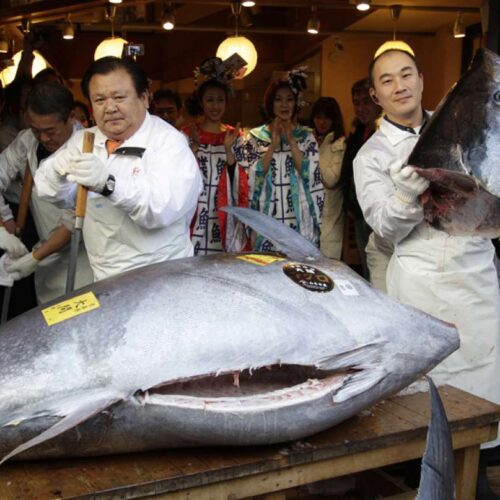Introduction
While the bluefin tuna is widely acknowledged to be a threatened fish, the price paid Thursday for one 593-pound catch is more a show of nationalism and marketing saavy than a sign of how endangered the tuna has become.
Bluefin tuna is a long-lived, highly migratory fish prized by sushi eaters for its red meaty flesh. The Eastern and Western Atlantic stocks of bluefin tuna have been so severely plundered that they were proposed for listing as an endangered species in 2009 – a designation strongly opposed by Japan, which consumes around 80 percent of the bluefin caught in the world. A recent investigation by the International Consortium of Investigative Journalists found that the black market trade in the Eastern Atlantic stock included nearly one in three fish caught.
It would stand to figure that the price paid by Kiyoshi Kimura, a Japanese restaurateur, would have been far higher had these black market fish not been driving down the price. But his big bid has more to do with national pride and salesmanship than the economics of scarcity.
Every year, the first auction of a Japanese-caught Pacific bluefin tuna attracts the attention of the sushi-loving nation. And for the past four years, the winning bidder has been from Hong Kong – a significant blow to the national psyche. The Chinese company, the Taste of Japan, set a record last year when it paid nearly $396,000 for a 754-pound tuna at the first fish auction of 2011.
The Chinese news service Xinghua in March put the average price of bluefin tuna in Japan around $10,000 for a single fish. That’s a lot, even for a fish that can weight more than 1,000 pounds. But Kimura paid 70 times than that more for his New Year’s delicacy: $1,238-per-pound.
Kimura, who is the president of a company that runs the Sushi Zanmai restaurant chain, told AP he wanted to keep the fish in Japan, “rather than let it get taken overseas.” The Wall Street Journal reported that cuts of the record-breaking tuna will be sold at regular prices ranging from $1.75 for a piece of the “akami” red meat to $5.45 for a slab of “otoro,” or fatty tuna, draped over a nugget of pressed rice. If sold at cost, each piece could be sold for as much as $96.
“Japan has been through a lot the last year due to the disaster,” Kimura added, referring to the tsunami and subsequent nuclear disaster. “Japan needs to hang in there. So I tried hard myself and ended up buying the most expensive one.”
But the spectacle surrounding the first bluefin tuna auction of the season leaves a bad tase in conservationists’ mouths. “We don’t agree with the use of an overfished and endangered species as a promotional gimmick,” Allen To, a marine conservation officer at the World Wildlife Fund, told the South China Morning Post after last years’ record-setting sale.
Read more in Environment
Environment
EPA hopes disclosure leads to greenhouse gas reductions
In release of new data, agency sees 25-year-old program as model to follow
Environment
EPA’s Toxics Release Inventory doesn’t offer full picture of pollution
Flawed database doesn’t capture all hazardous chemical releases


Join the conversation
Show Comments